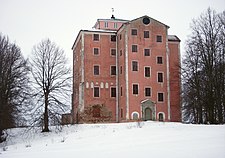Tynnelsö Castle
| Tynnelsö Castle | |
|---|---|
| Strängnäs Municipality, Sweden | |

Tynnelsö Castle
|
|
| Coordinates | 59°24′44″N 17°06′01″E / 59.41222°N 17.10028°ECoordinates: 59°24′44″N 17°06′01″E / 59.41222°N 17.10028°E |
| Type | Castle |
| Site history | |
| Built | Oldest parts probably from the 13th century |
| Built by | Several medieval bishops of Strängnäs |
| Battles/wars | Swedish War of Liberation |
Tynnelsö Castle (Swedish: Tynnelsö slott) is a castle in Sweden. It is located on Tynnelsö island in Lake Mälaren, a few kilometres north-east of Strängnäs. The castle was built during the Middle Ages by the bishops of Strängnäs.
The oldest parts of Tynnelsö Castle probably date from the 13th century. The castle is mentioned in written sources for the first time in 1282. From 1306, the estate belonged to the Diocese of Strängnäs and the castle was the property of the bishop. The castle was continuously expanded during the Middle Ages. During the time of bishop Thomas Simonsson, the castle is mentioned as one of the strongest in Sweden. A preserved list of inventories from 1443 lists the weapons housed in the castle at the time: 24 firearms, including several cannon, 52 crossbows, a barrel of crossbow bolts and 150 cannon balls. In the time of bishop Sigge (1449–63), the castle had a garrison of 100 men.
The castle saw action during the Swedish War of Liberation. It was besieged and conquered by the troops of Gustav Vasa and later used by his army as an arsenal during the . In 1527, it was confiscated by the crown of Sweden and turned into a crown estate. Gustav Vasa spent time there on several occasions, and his wife Margareta Leijonhufvud died at Tynnelsö Castle in 1551.
After the death of Gustav Vasa, the castle passed to his widow Katarina Stenbock and then to Duke Charles of Södermanland, the future Charles IX of Sweden, who started transforming it from a medieval castle to a Renaissance palace. He gave the castle as a gift to his first wife, the Maria of Simmern and, after her death, likewise to his second wife Christina of Holstein-Gottorp. Eventually it passed to his son Charles Philip, Duke of Södermanland. It was then inherited by his daughter Elizabeth Carlsdotter Gyllenhielm. It stayed in her family until the late 17th century, when it became the property of queen Hedvig Eleonora of Holstein-Gottorp.
...
Wikipedia
